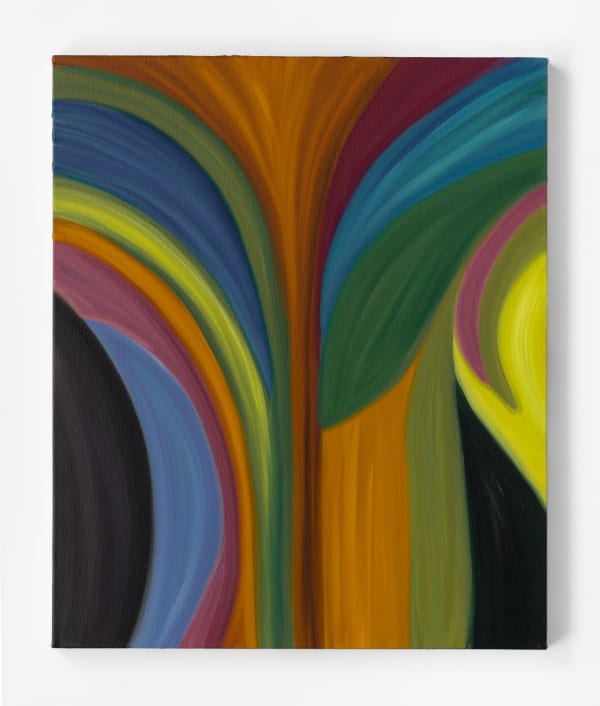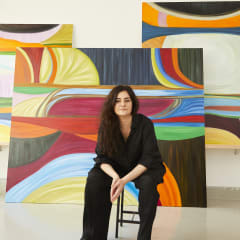Diffusion Marina Perez Simão
The Brazilian painter Marina Perez Simão tries to create a sense of ineffable wonder in her works as she brushes up against the limits of abstraction. In a world where we are supposed to know everything through the touch of a screen, the artist tries to conjure the awe that comes with experiencing a sense of being that was previously unthinkable. Her paintings open up possibilities for new states of matter beyond known solids, liquids, gases, and plasmas. The expanding energy that Simão evokes in undulating curves that link complex and contrasting colors in her paintings seems to diffuse across each of her works, blurring the edges between one work and another, inviting the audience to piece together how they might all be connected. This quest to connect her paintings beyond the borders of each canvas could be likened to the search for oneness that is sought by many spiritual traditions. If we were to look at her paintings on the atomic level, there would be no difference between inside, outside, you, her, or me.
“Diffusion” is defined as the net movement of anything, from the invisible atomic level to the perceivable spread of information, and it is an important process in all living things enabling substances to move in and out of cells. It is also the title of the artist’s first solo exhibition in Paris, where memories of her experience studying in this city twenty years ago diffuse into her experience of the eighteenth-century hôtel particulier space of the gallery Mendes Wood DM. Simão describes this new series of works as the most evocative of “landscape” in her practice to date. She thinks about landscape more as conjuring a space or a place, as opposed to describing an existing place, and plays with traditional elements of landscape painting like using several horizon lines and never using a vanishing point. However, the use of the word “landscape” in describing this new body of work seems to be a contradiction, given that she introduces us to a new format of vertically oriented paintings in the show (inspired in part by the vertically oriented proportions of the gallery); but the artist sees paradoxes as part of a dynamic process of seeking clarity. She is always thinking about inner and outer space, and “diffusion” relates to the particularities of the Mendes Wood DM Paris gallery space, acclimatizing it to evoke the feelings she gets when working in her studio in São Paulo.
Simão wanted to transform the Paris gallery into a space that feels like her studio, where the many paintings overwhelm you but also invite you to draw your own connections across the works. The mental and emotional bridges you create across the paintings enable you to comfortably inhabit a space full of dissonance and tame a sense of chaos into a rhythm. The show spans two floors of the gallery and intends to confront viewers with a paradoxical desire to see all the paintings simultaneously, although one cannot see them all at once. Just as perfume diffuses across a room, so does the energy of Simão’s paintings, and you get washed over with a sense of expansiveness. Simão was thinking about nineteenth-century panorama painting when making these works, particularly in relation to how painting could capture vastness and movement before the onset of cinema. She learned about these panoramas in her first year of school at the École Nationale Supérieure des Beaux-Arts in a course about the transcendence of painting by cinema and the transcendence of cinema by painting. The study of the unfolding of time, light, and movement that began in this course continues in her practice two decades later.
Simão, focusing on light and movement, aims to evoke a sense of endless expanse through small details, similar to how even a fragment of an image of a desert can open up a sense of a seemingly endless space. Deserts are full of the kinds of contradictions that Simão is drawn to in her thinking – they seem empty yet teem with life; we imagine them as spans of deep beige monochrome, but even a slight rain can bring on “super blooms” when desert sands are washed over with bright blankets of wildflowers sprouting from dormant seeds that were just waiting for the right conditions to come to life. Working across landscape formats and a new series of very vertical and narrow paintings, the artist tries to defy what it means to be boundless and to push how the eye can travel.
Each body of Simão’s work engages with a different kind of life and a particular feeling that she associates with different times as day turns to night and night turns to day. Diffusion engages with a “10 am kind of light” in which shifts in light are more about whether it is sunny or cloudy than whether it is about to be night or about to turn day. She was thinking about a sort of light that you feel when you sense that it might rain, but that it also might blow over. A sense of something that also contains its opposite, such as a rain cloud that does not release its rain, inspires the artist as something that pushes reality from being static. She hints toward colors that might pop with even more brightness after the rain; they are edging toward something. Pinks pervade this show. They could be associated with the chromatic range of desert colors but could equally be read as watery when we start noticing boats that become moons and sail into other universes. Pinks and yellows find new intensities for Simão in Paris but contain the same vessels for celestial navigation that we see across the practice, from boats to rockets to surfboards to UFOs. These vessels (which are signature forms in the artist’s work) allow us to push the limitations of where a human body can go, just as the artist tries to push the limitations of where our imaginations, and emotions unlocked by the act of imagining might lead us. Giving visitors the liberty to walk between the paintings and to compose their own associations, Diffusion is at conflict with division and hard definitions and is a place where potentiality exponentially multiplies.
— Diana Campbell *
* Diana Campbell is the artistic director of Dhaka based Samdani Art Foundation and chief curator of the Dhaka Art Summit.
-
 Marina Perez Simão, Untitled, 2024
Marina Perez Simão, Untitled, 2024 -
 Marina Perez Simão, Untitled, 2024
Marina Perez Simão, Untitled, 2024 -
 Marina Perez Simão, Untitled, 2024
Marina Perez Simão, Untitled, 2024 -
 Marina Perez Simão, Untitled, 2024
Marina Perez Simão, Untitled, 2024 -
 Marina Perez Simão, Untitled, 2024
Marina Perez Simão, Untitled, 2024 -
 Marina Perez Simão, Untitled, 2024
Marina Perez Simão, Untitled, 2024 -
 Marina Perez Simão, Untitled, 2024
Marina Perez Simão, Untitled, 2024 -
 Marina Perez Simão, Untitled, 2024
Marina Perez Simão, Untitled, 2024 -
 Marina Perez Simão, Untitled, 2024
Marina Perez Simão, Untitled, 2024 -
 Marina Perez Simão, Untitled, 2024
Marina Perez Simão, Untitled, 2024 -
 Marina Perez Simão, Untitled, 2024
Marina Perez Simão, Untitled, 2024 -
 Marina Perez Simão, Untitled, 2024
Marina Perez Simão, Untitled, 2024 -
 Marina Perez Simão, Untitled, 2024
Marina Perez Simão, Untitled, 2024















